Adam Yamey's Blog: YAMEY, page 24
February 14, 2025
Transillumination
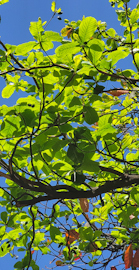
Sunlight through leaves
Filtering gently each morning
A joy to behold
February 12, 2025
Painting scenes of daily life on sheets of mica in colonial India
ONE CAN PAINT ON paper, canvas, glass, textiles, ceramics, and walls. Until yesterday (9 February 2025) when we visited an exhibition at Bangalore’s Museum of Art and Photography (‘MAP’), I did not know that paintings have been made on sheets of the translucent mineral mica. Mica has been, and still is, mined in great quantities in India.
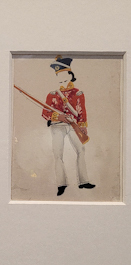
Because of its translucency, lanterns made with mica, on which images have been painted, have been used in both Hindu and Muslim ceremonies. Since the eighteenth century artists have been creating paintings on mica, usually using watercolours or gouache mixed with an adhesive to ensure that the colours stick to the mica. Because the colours are on a translucent material that does not absorb any of the pigments, rather than opaque paper that inevitably absorbs some pigment, they appear much more vibrant on mica than on paper.
Murshidabad, now in West Bengal, was an important centre of mica painting. Initially, artists concentrated on paintings and portraits commissioned by local nawabs and other members of the Indian aristocracy. With the arrival of Europeans in Murshidabad and other parts of Bengal in the late eighteenth century, the artists began depicting subjects designed to appeal to European customers. Europeans were particularly attracted to the paintings on mica. The subjects included illustrations of daily life and customs. They are therefore an interesting record of life in Bengal (and other parts of India) during the late eighteenth century.
The exhibition at MAP consists of a collection of paintings both on mica and on paper. These images were designed to appeal to European visitors (both short- and long-term) to India and are examples of Company Paintings (East India Company).
Many of the paintings on mica depict people who appear to have no faces. Originally, these paintings had faces painted in gouache. However, the faces were painted on a layer of mica placed above that on which the rest of the subject was painted. This was done to give the images a three dimensional quality. Sadly, many of these upper layers have been lost, resulting in literally a loss of face.
The exhibition at MAP was well displayed. An extremely informative booklet about the exhibits and mica painting was available free of charge. I am pleased we visited the show not only because it was both beautiful and fascinating, but also because we had visited Murshidabad a few weeks earlier.
PS mica painting was done in parts of India where mica was plentiful, such as Andhra Pradesh, Madhya Pradesh, Tamil Nadu, Rajasthan, Bihar, and Jharkhand.
Paintings scenes of daily life on sheets of mica in colonial India
ONE CAN PAINT ON paper, canvas, glass, textiles, ceramics, and walls. Until yesterday (9 February 2025) when we visited an exhibition at Bangalore’s Museum of Art and Photography (‘MAP’), I did not know that paintings have been made on sheets of the translucent mineral mica. Mica has been, and still is, mined in great quantities in India.

Because of its translucency, lanterns made with mica, on which images have been painted, have been used in both Hindu and Muslim ceremonies. Since the eighteenth century artists have been creating paintings on mica, usually using watercolours or gouache mixed with an adhesive to ensure that the colours stick to the mica. Because the colours are on a translucent material that does not absorb any of the pigments, rather than opaque paper that inevitably absorbs some pigment, they appear much more vibrant on mica than on paper.
Murshidabad, now in West Bengal, was an important centre of mica painting. Initially, artists concentrated on paintings and portraits commissioned by local nawabs and other members of the Indian aristocracy. With the arrival of Europeans in Murshidabad and other parts of Bengal in the late eighteenth century, the artists began depicting subjects designed to appeal to European customers. Europeans were particularly attracted to the paintings on mica. The subjects included illustrations of daily life and customs. They are therefore an interesting record of life in Bengal (and other parts of India) during the late eighteenth century.
The exhibition at MAP consists of a collection of paintings both on mica and on paper. These images were designed to appeal to European visitors (both short- and long-term) to India and are examples of Company Paintings (East India Company).
Many of the paintings on mica depict people who appear to have no faces. Originally, these paintings had faces painted in gouache. However, the faces were painted on a layer of mica placed above that on which the rest of the subject was painted. This was done to give the images a three dimensional quality. Sadly, many of these upper layers have been lost, resulting in literally a loss of face.
The exhibition at MAP was well displayed. An extremely informative booklet about the exhibits and mica painting was available free of charge. I am pleased we visited the show not only because it was both beautiful and fascinating, but also because we had visited Murshidabad a few weeks earlier.
PS mica painting was done in parts of India where mica was plentiful, such as Andhra Pradesh, Madhya Pradesh, Tamil Nadu, Rajasthan, Bihar, and Jharkhand.
February 11, 2025
Traditional inlaid metalwork used to make contemporary art
BIDRI WORK IS a method for creating decorative metal items. Its name derives from Bidar in Karnataka, where this technique was developed and is still used. Objects are made by casting a black coloured alloy containing copper and zinc in the proportion 1: 16. Then, craftsmen use fine chisels to engrave often very intricate patterns on the surface of the cast alloy. These grooves are then filled by hammering fine silver wire into them. So, the resulting item is a dark metal object inlaid with silver.
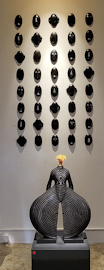
Today, 8 February 2025, we visited the Kaash gallery, which is housed in a well-preserved traditional Bangalore bungalow. One of the three small exhibitions currently being displayed is a collection of Bidri art works. The artefacts were designed by Stephen Cox, a British artist, and were made by Abdul Bari, a Bidri craftsman. The resulting artworks are both unusual and beautiful.
The two other exhibitions at Kaash were: colourful contemporary seating made by weavers from Tamil Nadu and designed by David Joe Thomas, and some sculptures and lighting by Italian artist Andrea Anastasio.
Our visit to Kaash was very satisfying. Although small, it is a place in Bangalore that art-lovers should not miss.
February 10, 2025
A holy roller in Bangalore (Bengaluru)
ON THE SIXTH of February 2025, I boarded an auto (autorickshaw, tuk-tuk) in central Bangalore. It contained a selection of Christian religious leaflets and booklets, which passengers were invited to take. Some of them were in English, the rest in Kannada (the main language spoken in Karnataka). The driver had adorned his auto with Christianity related stickers.
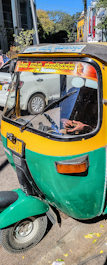
As we wove our way through the busy traffic, I wondered if I was travelling in a type of ‘Peace Auto’. The Peace Auto movement in Bangalore was started by Anil Shetty in October 2013 to improve the relationships between auto drivers and their passengers. To quote from Shetty:
“Peace Autos is an initiative to make peace between the City and auto drivers. There is a one-sided argument that all auto drivers are bad. But that’s not true. I want to make them feel responsible.” (https://www.deccanherald.com/india/karnataka/bengaluru/a-surprise-experience-peace-auto-2189174).
When I reached my destination, the driver said (in English):
“God bless you.”
I asked him if his vehicle was a Peace Auto. He replied:
“No, it is Jesus Auto”.
February 9, 2025
Only one airport, only one flight
THE FORMER FRENCH colony, now a Union Territory of India, Pondicherry, has its own small domestic airport. It is just over 3 miles from the city centre (as the crow flies). However, because of the traffic and the winding nature of our route, it took almost 30 minutes to reach the airport.
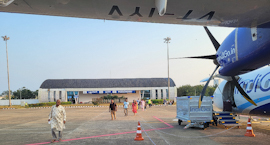
After we had booked a flight from Pondicherry to Bangalore, our daughter, who had taken the same flight twelve months earlier, warned us that the airport at Pondicherry had limited resources but no refreshment facilities.
Prior to arriving at the airport, I wondered if it would be even more rudimentary than the tiny airport at Khandla (in Kutch, Gujarat). Even that airport has a refreshment kiosk. With these thoughts in mind, and armed with a bag full of snacks and soft drinks, we headed off to Pondicherry Airport.
To my great surprise (and relief), we found that the passenger terminal at Pondicherry Airport is housed in a large, airy, well-ventilated, modern, comfortable, cylindrical building. And it has a refreshment kiosk, which sells only soft drinks.
The airport was first opened in 1989, and used for two years. However, lack of financial success caused it to be closed in 1991. After reconstructing the airport and its runways, it was reopened in 2012. The new terminal was inaugurated in 2013. Currently, Indigo Airlines operates flights to and from this airport. There is one daily flight : Bangalore to Pondicherry to Hyderabad, and another from Hyderabad to Bangalore via Pondicherry. We took the latter. The propellor plane on which we flew was an ATR 72-600 (built by a French company, ATR), which can carry 78 passengers.
What I particularly liked about the airport is that instead of reaching the aircraft by an air-bridge or on a bus we simply walked across the tarmac from the terminal to the ‘plane.
As we drove from Pondicherry to the airport, Shiva (our taxi driver) casually remarked about Pondicherry:
“Only one airport, only one flight.”
February 8, 2025
Demolished thrice but still standing and fully used in Pondicherry
FIRST THE DUTCH demolished it in 1693. Then, it was replaced on the same site, only to be demolished again in about 1730. Once more, a new one was constructed on the same site, and this was then demolished by the British in 1761. The current version of this building, the Immaculate Conception Cathedral in Pondicherry, was completed in 1791, and is still in use today. Regular Roman Catholic services are held here in the Tamil, French and English languages.
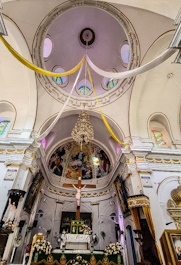
Today (3 February 2025), while waiting for a nearby shop to open, we sat quietly in the cool aisle of the Cathedral. After a while, some beautifully dressed people entered. They walked up to the front of the church close to the high altar, and posed for photographs. It was obvious that amongst them was a just married couple. The bride was wearing a sari, had flowers in her hair, and a luxuriant flower garland around her neck.
As they walked away from the altar towards the open west door, they passed us, and my wife asked them if they had just married. They accepted our congratulations and asked us to join them. We did and as we stood next to the newlyweds, who had just married in another church, the four of us posed for photographs. Then, the bride asked us to bless them by touching their foreheads. We were moved by this request.
The marriage party went on their way, and we crossed the road to enter the huge bookshop that had just opened.
February 7, 2025
The hammer and sickle near the seashore in Pondicherry
THE LETTERS ‘CITU’ stand for the Centre of Indian Trade Unions, which was founded in 1970. Its ‘logo’ includes the hammer and sickle, a symbol first used on some Chilean coins as early as 1894. However, it became widely recognised after 1917 when it was used as a symbol during the Russian Revolution, and long after it was over.
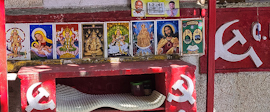
Today, I spotted a small street stand erected in Pondicherry by the CITU. It is located on the corner of Rue du Bazar St Laurent and Beach Road (Goubert Avenue), which runs along the seafront. It has three white hammer and sickles, each on a red background. One of these symbols faces in the opposite direction to the other two.
Now, here is what interested me. Two of the Communist symbols decorate the stone supports of a short table or bench. Running along the length of the bench and slightly above it, there is a row of religious images. Four of them depict Hindu deities, three of them are images of Christianity, and one, showing two mosques and the Holy Koran, is connected with Islam.
I suppose that this might reflect the fact that local members of the CITU are adherents of these three religions. But, I am only guessing.
February 6, 2025
Dog day afternoon
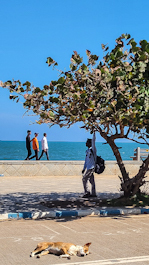 Pondicherry, India
Pondicherry, IndiaSun beating down
Canine lying beyond the shade
Dog day afternoon
February 5, 2025
A café with a history on the seashore at Pondicherry
BEACH ROAD RUNS alongside the seafront of Pondicherry. It is just over 1.3 kilometres in length. There are many buildings lining the landward side of the road (its west side), including hotels, restaurants, a memorial to BR Ambedkar, the lighthouse and the Customs House. However, there is only one on the seaward side, close to the seashore. Today, this building with a veranda on its sea facing side is a pleasant refreshment outlet called Le Café. It stands a few metres south of the tall statue of Mahatma Gandhi, also on the seaward side of Beach Road.
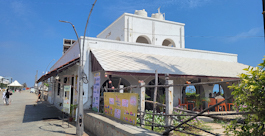
The café contains some historical photographs of Pondicherry. One of them shows the long pier that commenced where Gandhi now stands. The pier was irreparably damaged during a terrible storm in the early 1950s, probably 1952. All that remains of it are some wooden stumps projecting from the sea some considerable distance away from the shore. Where Gandhi stands today was Place de la République when Pondicherry was a French colony.
There has been a building on the site of Le Café since at least the end of the 17th century, as can be seen on a map published in 1793. For many years, the building housing the café was the Port Office of Pondicherry. It can be seen quite clearly in a photograph taken before 1870. Then, it had only a single storey. A small upper storey has been added since then.
Sometime after the pier was polished off by the storm, the building was remodelled to serve as a café. Run by a state managed concern, food and non-alcoholic drinks can be obtained here at reasonable prices. In the intense heat of midday and the early afternoon, the veranda of Le Café is a pleasant place to relax in the breezes that pass through it.



